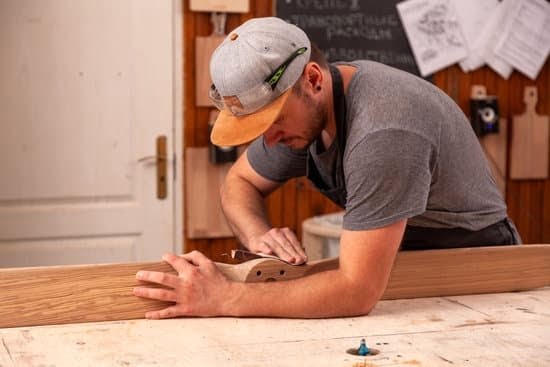Are you wondering how to remove a handrail from woodwork? Whether you’re renovating your home, replacing the handrail with a new one, or simply making repairs, knowing how to safely and effectively remove a handrail is essential. In this article, we will provide a step-by-step guide on removing a handrail from woodwork while avoiding damage to the surrounding area and ensuring safety.
Removing a handrail may be necessary for various reasons, such as updating the design of your space, addressing wear and tear, or making repairs. Regardless of the reason, it’s important to approach the task with precautions and proper techniques to prevent any accidents or damage. This guide will equip you with the knowledge and skills needed to tackle this project.
Before getting started with the removal process, it’s crucial to gather all the necessary tools and materials required for the job. Additionally, understanding how to identify the type of handrail securing method used will ensure that you are prepared for any specific challenges that may arise during the removal process. So let’s dive into this comprehensive guide on safely removing a handrail from woodwork.
Tools and Materials Needed
When removing a handrail from woodwork, having the right tools and materials is crucial to ensure a successful and safe process. Here is a comprehensive list of everything you will need to complete this task:
- Screwdrivers: Phillips head and flat head screwdrivers will be necessary for unscrewing any screws holding the handrail in place.
- Wrenches: A set of wrenches or an adjustable wrench may be needed if the handrail is secured with bolts instead of screws.
- Safety goggles: It is essential to protect your eyes while working with tools, especially when removing hardware in case any debris or metal parts fly off during the process.
- Gloves: Wearing gloves can help protect your hands from sharp edges or splinters while handling the handrail and hardware.
Other key items you may need include a putty knife, wood filler, sandpaper, and paint or stain (if you plan on patching up any holes left by the handrail removal). Once you have collected all the necessary tools and materials, you can move on to preparing for the task by clearing the surrounding area and putting on protective equipment. By following these steps, anyone can successfully remove a handrail from woodwork without causing any damage or injury.
Preparation
Before starting the process of removing a handrail from woodwork, it is essential to take the necessary preparation steps to ensure the task is completed safely and effectively. Here are the steps to prepare for removing a handrail, including clearing the surrounding area, putting on protective equipment, and more:
1. Clear the surrounding area: Before beginning any work on removing the handrail, clear the area around the woodwork to create a safe and unobstructed workspace. Remove any objects or furniture that may get in the way or become damaged during the removal process.
2. Put on protective equipment: To protect yourself from potential injuries and hazards, it is crucial to wear safety goggles, gloves, and any other suitable protective equipment. This will help prevent any accidents or mishaps while working on removing the handrail.
3. Gather all necessary tools and materials: Ensure that you have all the required tools and materials at hand before starting the removal process. Some essential tools for removing a handrail from woodwork include screwdrivers, wrenches, pliers, and a drill if needed.
Remember that taking these preparation steps is crucial for ensuring a smooth and safe experience when removing a handrail from woodwork. By properly preparing for this task, you can minimize potential risks and complete the job efficiently. Always prioritize safety by wearing protective gear and creating an organized space to work in.
Identifying the Type of Handrail
When removing a handrail from woodwork, it is crucial to first identify the type of handrail and how it is secured to the wood. This information will determine the approach and tools needed for safe removal. There are different types of handrails, and they may be secured with screws or bolts, so it is important to know how to distinguish between them.
Secured With Screws or Bolts
To begin the process of removing a handrail from woodwork, it is essential to inspect how it is attached. Handrails can be secured with either screws or bolts. If it is secured with screws, a screwdriver will be the tool of choice for removal. On the other hand, if the handrail is fastened with bolts, a wrench will be necessary to unfasten them.
Distinguishing Different Types of Handrails
There are different types of handrails that can be found in woodwork, including wooden handrails, metal handrails, and composite handrails. Each type has its own unique characteristics that may affect the removal process. It is important to carefully examine the material and construction of the handrail before attempting to remove it.
By understanding how the handrail is secured and identifying its type, individuals can proceed with confidence in their ability to safely and effectively remove a handrail from woodwork without causing damage or injury. Taking these initial steps will set the stage for a successful removal process while ensuring that safety precautions are followed throughout.
Removing the Handrail
Removing a handrail from woodwork may seem like a daunting task, but with the right tools and knowledge, it can be easily accomplished. Before starting the process, it is crucial to gather all the necessary tools and materials. These may include screwdrivers, wrenches, safety goggles, sandpaper, wood putty, and paint or finish to match the existing woodwork. Additionally, wearing protective gear such as gloves and safety goggles is essential to prevent any potential injury.
Once all preparations are complete, it is important to identify the type of handrail that is being removed. Some handrails are secured with screws, while others may be fastened with bolts. Carefully inspecting the handrail will help determine which method of removal is required and ensure that unnecessary damage is avoided.
In the case of handrails secured with screws, using a screwdriver will allow for easy unscrewing of the handrail from the woodwork. It’s crucial to take your time during this process in order to avoid stripping or damaging the screws or surrounding wood. If bolts are used for securing the handrail, a wrench should be used to unfasten them carefully without causing any harm to the wood.
After successfully removing the handrail from the woodwork, it’s important to address any holes or damage left behind. This involves patching up any holes with wood putty and sanding down any rough areas before refinishing or repainting the woodwork as needed.
| Tools Needed | Materials Needed |
|---|---|
| Screwdrivers | Sandpaper |
| Wrenches | Wood putty |
| Safety goggles | Paint or finish |
Patching and Repairing
After successfully removing a handrail from woodwork, it is important to address any holes or damage left behind. Depending on how the handrail was attached, there may be screw or bolt holes that need to be filled. To do this, you will need wood filler or putty that matches the color of your woodwork. After applying the filler or putty, allow it to dry completely before sanding the area smooth.
In addition to patching up holes, you may need to consider refinishing the woodwork. Often, when a handrail is removed, it can expose areas of the wood that have not seen light or wear for some time – resulting in variations in color across the space where the rail once was.
To remedy this issue, simply sand down these areas and apply a matching stain to restore a consistent finish. Once stained, allow ample time for drying before adding a protective topcoat to seal and protect your newly refinished woodwork.
Finally, it’s important to take adequate safety precautions when patching and repairing woodwork. Wear safety goggles and gloves while handling fillers, putties, or power tools like sanders. It’s also wise to work in a ventilated area when using staining and finishing products. By taking these steps and following this process after removing a handrail from your woodwork, you can ensure that your space looks polished and well-maintained after completing this project.
By following these steps carefully and methodically after removing a handrail from your woodwork will ensure that any potential damage is properly addressed and repaired without causing additional harm or injury to yourself or others helping with the project.
Safety Precautions
When it comes to removing a handrail from woodwork, safety should always be the top priority. It is essential to take the necessary precautions to avoid any potential injuries or accidents during the removal process. This section will emphasize the importance of safety and provide tips on how to stay safe while working on this task.
Wearing Protective Gear
Before starting the process of removing a handrail from woodwork, it is crucial to wear the appropriate protective gear. Safety goggles should be worn to protect the eyes from any flying debris or particles that may occur during the removal process. Additionally, gloves are essential for protecting your hands from splinters and other potential hazards. Wearing long sleeves and pants can also help prevent any scratches or cuts while working with tools.
Working With a Partner
In some cases, removing a handrail may require more than one person, especially if it is large or heavy. Working with a partner can make the removal process easier and safer. Having an extra set of hands can help stabilize the handrail while you work on unscrewing or unfastening it from the woodwork. It also provides an added layer of safety in case something goes wrong during the removal process.
Using Tools Properly
It is important to use tools properly and with caution when removing a handrail from woodwork. Make sure to use screwdrivers, wrenches, or any other tools according to their intended purpose. Avoid using excessive force that could potentially lead to injury or damage to the woodwork. If you are unsure how to remove a handrail using specific tools, consider seeking guidance from a professional or someone with experience in this type of task.
Taking these safety precautions into consideration will help ensure a smooth and accident-free removal of a handrail from woodwork while keeping everyone involved safe from harm.
By following this comprehensive guide, anyone can successfully remove a handrail from woodwork without causing any damage or injury.
Conclusion
In conclusion, removing a handrail from woodwork can be a straightforward task when approached with the right tools and knowledge. It is essential to start by gathering all the necessary tools and materials, including screwdrivers, wrenches, and safety goggles, to ensure that the job is done safely and efficiently. Preparation and safety precautions are also crucial steps in this process, as they can help prevent accidents and damage to the surrounding area.
Once the type of handrail has been identified, whether secured with screws or bolts, the removal process can begin. Carefully following step-by-step instructions will ensure that the handrail is unscrewed or unfastened without causing any damage to the woodwork. After removing the handrail, patching up any holes or damage left behind is important to maintain the aesthetic appeal of the woodwork.
Lastly, when removing a handrail from woodwork, it’s vital to consider safety at all times. Wearing gloves and protective gear should never be overlooked as it provides a layer of protection against potential injuries. Following these final tips and advice will undoubtedly lead to a successful removal of a handrail from woodwork while maintaining safety throughout the entire process.
Frequently Asked Questions
How Do You Remove a Wooden Handrail?
Removing a wooden handrail typically requires the use of tools such as a screwdriver, pry bar, and possibly a saw. It’s important to first remove any screws or nails holding the handrail in place, then carefully pry it away from the wall or posts.
How Hard Is It to Replace Stair Railings?
Replacing stair railings can vary in difficulty depending on the specific design and materials involved. In general, it involves removing the old railing, preparing the area for the new railing, and then installing the new railing using proper tools and techniques.
How Do You Finish a Wooden Handrail?
Finishing a wooden handrail involves sanding down any rough spots or imperfections, applying a wood stain or paint if desired, and then adding a protective finish such as polyurethane to seal and protect the wood. Proper ventilation and safety precautions should be taken when using these finishing products.

Hi everyone! I’m a woodworker and blogger, and this is my woodworking blog. In my blog, I share tips and tricks for woodworkers of all skill levels, as well as project ideas that you can try yourself.





